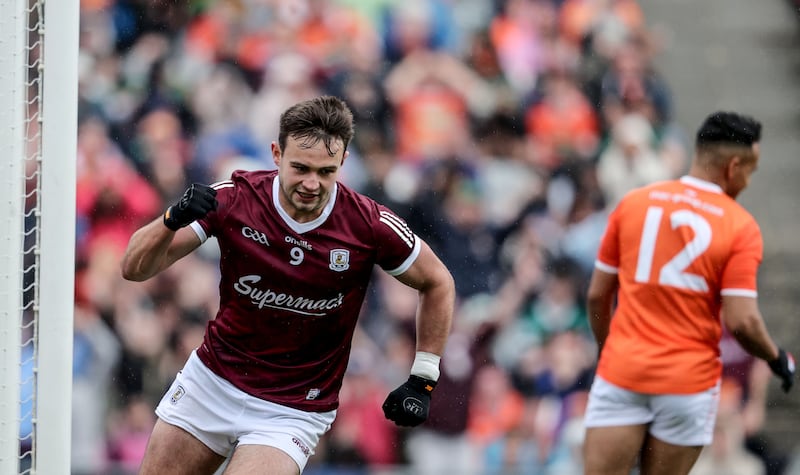The story of the weekend was not the melee. It was the re-emergence of Galway as an All-Ireland calibre football force. Armagh against Galway was the game that saved the championship summer.
This was such an epic game and generated such talk and controversy afterwards that it is easy to forget the unpromising beginning for Galway. Aidan Nugent fired over a quick point and then Paul Conroy kicked a ball over the sideline — a rare occurrence. For the first 10 minutes Armagh looked razor sharp and raced into a 0-4 to 0-1 lead.
Then Galway forced a turnover at the top of the D and Matthew Tierney scored a point. That was quickly followed by another turnover when Rian O’Neill and the Armagh attack was gobbled up and the ball was rapidly transferred downfield. And just like that it was 0-4 to 0-3 and the contest began to take us to all sorts of unexpected places.
It was then I sat up and began to take notice of Galway. They are a different team this year. They looked very well conditioned and strong. Throughout the afternoon they were able to engineer situations where they were defending one-on-one and could then quickly double and even treble team the Armagh ball carrier, overwhelming him and turning the ball over.
READ MORE
It was the speed with which they made that switch from an isolated defender to a numerical advantage that struck me. Galway are proactive in defence. Their mindset is to hunt down the opposition. This requires an extremely high level of fitness, of collective understanding and of discipline.
It reminded me of last year’s championship: the midblock morphing into an all-out protection of the D, which was the fundamental part of Tyrone’s set up. Galway mirror this. They defend that midblock but are ready to sprint back in to cover that D and consistently create the numbers advantage to win back the ball. And they have married this savage intensity — a very confrontational way of defending — along with absolute discipline. Their conditioning has gone through the roof. And their defensive work has improved beyond recognition.
They are still Galway. They will give teams a chance to play and if you are in position to make hay, then great. That is why it became such an end-to-end exhilarating contest. But if you dally on the ball then beware. Take, for instance, the example of Jarly Og Burns — sitting out wide and taking the ball at 26.26 on the clock. By 26.31 Galway had four players arriving, intensely pressuring him. They won the ball and got a scoring free.
Aidan Nugent was the recipient of Rian O’Neill’s sublime disguised pass at 32.33. Here was a goal chance — for a split second. By 32.36 it was a four v one for Galway. They came away with the ball and broke up field and levelled the game.
What Padraic Joyce and his management team will be most happy with is that their scores were not coming from unforced errors by Armagh. It came from their own industry. And that will tell Padraic and the team that if they can continue to get that part of their game right then they can control their own destiny. It communicates the message: if we do this and get the ball back, then we will score. Because they know they have the capacity to shoot a big score.

During the injury period in the first half there was another Armagh attack turned over and Galway were coming through in maroon waves. That was the moment everyone in the stadium realised that this was the pattern. And it was formidable. And it suggested a long day for Armagh.
And that remained the pattern in the second half. There was no shadow tackling. Galway wanted to make contact- and were prepared to give away the odd foul and scoreable free. Armagh were living on courage and opportunism, but their scoring rate was slowing all the time. And as I watched Galway take command, it elevated the possibilities for them hugely in my mind. Yes, they face a very tough and specific battle against Derry. But they will also be a tough nut to crack. The statistics do not lie, and the work rate does not lie.
Galway had the creativity and boldness to try to unlock and attack Armagh in diverse ways
When in possession they were determined not to take the ball into contact. They like to get runners ahead of the ball. They want to isolate Shane Walsh and give him a chance to attack his man. They look for long balls into Damien Comer and Rob Finnerty. They gave the fisted ball inside, a diagonal ball or two into Comer, from which he almost had a punched goal to the net.
What I liked about that chance was how Dylan McHugh created it with his kick inside. He identified that the one v one was on behind the sweeper. The sweeper was playing strong side and he figured he could play it in behind both sweeper and defender and he had the skill set in his delivery. I have seen many moments in many games this year when that chance was on — but it was not taken.
Galway had the creativity and boldness to try to unlock and attack Armagh in diverse ways. By Shane Walsh running aggressively at his man, he clears out that area of the pitch and Rob Finnerty was sitting in the pocket, stepping into that space, and popping the ball over the bar. It is a facsimile of what Dublin have been doing for years with Dean Rock.
Then, five minutes into the second half, came the Galway goal, which broke the game open. Matthew Tierney crashed a fine shot off the crossbar, Dylan McHugh won it and started a very well worked and unusual goal. Because very rarely does a team convert a second chance like that. The five Armagh men were drawn to the ball and there were two Galway forwards left completely free to finish the ball to the net.
Then, they pressed up on the kick out, won possession, worked a score and opened up a four-point lead.
Their high intensity composure in the final third of the field was a further string to their bow. One score stood out: it was 44.10 on the clock and Galway kept working the ball until 45.44, when Rob Finnerty was picked out by Johnny Heaney for a tap over point. There was real quality in the tempo and pace and patience in that move. That will be tested against Derry. Because Derry will not come out to play. They will invite Galway to try to unpick them.
They are relying on teams losing composure when playing this way against them. But Galway showed in that minute and a half that they can pick a team off through patient, intricate passing. One last example of the added dimensions to Galway’s game. Finnian Ó Laoí was on the field for 10 seconds as a blood substitute when he scored a point. It came from a long kick out and Paul Conroy got hands to it and two or three Galway men came looking for the break with immense hunger and aggression.
That moment can tell you a lot about a team. There is hunger and ambition and just this huge raw desire. That is a good sign in a team. Because it was just a primal want that won that ball for them. Nothing else. It came from two decades of no All-Ireland semi-final appearance.
[ Kevin McStay: GAA must stop facilitating the easy acceptance of foul playOpens in new window ]
Then came the red card for Armagh. And Galway were stretching the game out, by the 71st minute they were six points up and the game looked over. This is where we need to pause. For all the positives, Galway have a lot of sorting out to do — and Derry will be aware of their pressure points.
What are these?
The first is their mistakes in their own defensive third. Kieran Molloy played a careless handpass to Stefan Campbell which gave Armagh a handy point. Sean Kelly later fisted a pass to Molloy even though he wasn’t looking at the ball, let alone for it. Then came the indecision for Armagh’s first goal, with no Galway player taking control of the high ball in.
The second goal originated in the decision by goalkeeper Conor Gleeson to blindly pass the ball out of defence. I couldn’t understand why Conor wanted to pass it anyway. He had possession and had two Armagh defenders swarming him and he could have held it and showed the referee he was trying to get out.
It was a desperate pass, and it did not have to be. Armagh’s third goal is also one for the Galway forensic team. Rian O’Neill mis-hit a shot and the ball was allowed to bounce in the box. That cannot happen. The Armagh forwards were lining up to smash home the break. Gleeson was under ferocious pressure, and nobody took control — again — and Rory Grugan capitalised. The last mistake was Shane Walsh’s hugely ambitious cross field ball with 20 seconds left of the eight minutes of injury time. Go to the corner and keep the ball!
Now, if that was the first time he’d done it, I would say that was a very unfortunate moment for a brilliant player. But in the 55th minute, Shane had done the same thing. He played a cross field ball which Armagh won, and it resulted in a pointed free. So, he got the lesson. And I cannot believe that he did not use that reference point in the closing seconds.
These are all similar errors, and they boil down to not taking control of the situation.
And that comes down to psychology — keeping composure and mental sharpness and dealing with things. Those hesitations can be fatal when you are trying to win an All-Ireland.
But overall, I really liked what I saw in Galway. I liked their defensive structure and their transition to attack. They did well on their kick outs and were ravenous for breaking ball all over the field. The high intensity composure in the final third is the trait they will need more than any other against Derry — and it looks substantial. And then there is the quality of their players all over the field. It is a radical leap forward in the space of a year.
And if Galway can manage to navigate the next hurdle, then they will give anyone their fill of it in the All-Ireland final.














